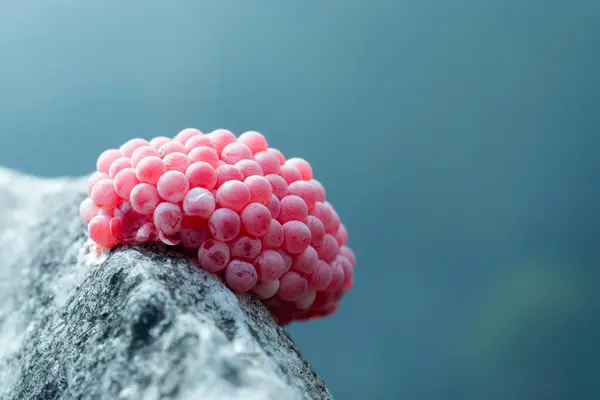What is it? Is it a snail? But how did the snail enter your aquarium when you didn’t buy it? If you are confused about this, there is a story behind it that you need to hear.

One of the scariest things faced by an aquarium owner is the sudden explosion of freshwater snails. Even if one arrives, there will be several more arriving soon.
In this post, we’re going to tell you about what you should look for if you want to prevent freshwater snails from hatching eggs inside your tank and what needs to be done if you’re too late in detecting them.
Snail eggs – How do they look?
Different species of snails will hatch different types of eggs and in the case of freshwater snails, their eggs are very easy to identify inside a freshwater aquarium. The eggs of snails are usually attached together in the form of a clutch and can have transparent sacs which hold them together in one place. Snail eggs usually look like small and clear jelly bubbles that change color based on the snail species that hatch them.
When the eggs are fertilized, their color may usually change and you may find small black spots after a short span of time. This is a clear indication of the fact that the yolks are gradually developing. Unfertilized eggs usually don’t change their color but can start smelling like rotten eggs after the passage of some time. After a span of 3-4 weeks, it can be safely said that the clutch of eggs was not successful and they won’t hatch.
What are the ways in which snails reproduce?
As already mentioned earlier, every species of snail is different, where some are asexual and some are sexual. A few asexual species of snails can also reproduce through hermaphroditic means. In case of most favorable conditions, there are a few snail species that lay eggs several times a month.
What is the position in which snails lay eggs?
One of the main ways in which freshwater snails enter your aquarium without your notice is through living plants. Snails love laying their eggs on the lower portion of the leaves and the tank owners may not spot it as it is difficult to spot. You also need to know that snails can lay eggs in another aquarium, under the ricks, or in driftwood. Hence, it is advisable to properly dip, examine, and quarantine new items that can enter your fish tank.
There are a few other species of snails that love to hatch eggs on the portion of the glass. Snails that belong to the Ampullariidaw family are also known as apple snails and they have both lungs and gills from breathing inside water and outside. This feature in their body helps them lay their eggs in various places. The mystery snail is one of the most common species of the Ampullariidae family that you’ll come across.
What are the things that you can do with snail eggs?
You have a few ways in which you can handle the eggs of snails as soon as you find them. The relationship shared by aquarists and snails is a contentious one and hence you have to make sure you have who welcomes mollusks when others despise them. The perfect choice for you will depend on your personal choices, the requirements of your tank, and the safety of your aquarium inhabitants. A few ways in which you can tackle snail eggs are:
Keep them intact
Are you looking for a hands-off approach toward snails’ eggs? You can retain the eggs and allow them to naturally hatch them. The eggs of freshwater snails are self-sufficient and hence you don’t need to play any part in initiating the process of hatching. There is a sac that will surround the egg and will help in lifting them, thereby providing nutrients and protection to their eggs. When you have snails in your tank, it can be extremely beneficial for the entire environment of the fish tank.
Snails play a vital role in cleaning. They help in picking up plant waste that could otherwise ruin the conditions of the water. Moreover, snails are great algae eaters and hence you will never find an overgrowth of algae inside the fish tank.
Use the eggs to feed other fishes
When you have Fish species that love feeding on snails, you can create a fantastic food source for them. There are few types of fish that entirely thrive on calcium-rich and high-protein meals. For example, puffer fish loves to munch on those hard shells of snails in order to keep their teeth and jaw in good shape. Few other fishes that have a great appetite for such snails or mollusks include:
- Cory Catfish
- Yoyo Loach
- Dwarf Chain Loach
- Betta Fish
- Bala Shark
- Zebra Loach
- Clown Loach
Dispose them off before they hatch
This is certainly the final option that you can take while handling snail eggs. Just dispose of them much before they hatch. When you are the owner of a freshwater aquarium, it is understandable that you will not want snails inside there. For Aquarists, snails are nothing more than a nuisance. Snails, when they grow in population, produce a lot of biology just as any other inhabitants of the tank. So if there are hundreds of snails in your aquarium, can you imagine the amount of waste that they will produce? Hence it is always better to dispose of the eggs before they hatch.
Conclusion
To conclude, it can be said that Snail eggs when found in a freshwater aquarium don’t mean the end of the world. You have to know how to deal with them so that you can prevent them from occurring in the future. Case you are not pretty sure about how to handle a snail eggs situation inside of a freshwater aquarium, keep in mind all the above-mentioned options. Just keep in mind that you can’t let snail eggs grow in your aquarium and hence you need to make a fast decision about how to deal with them.







